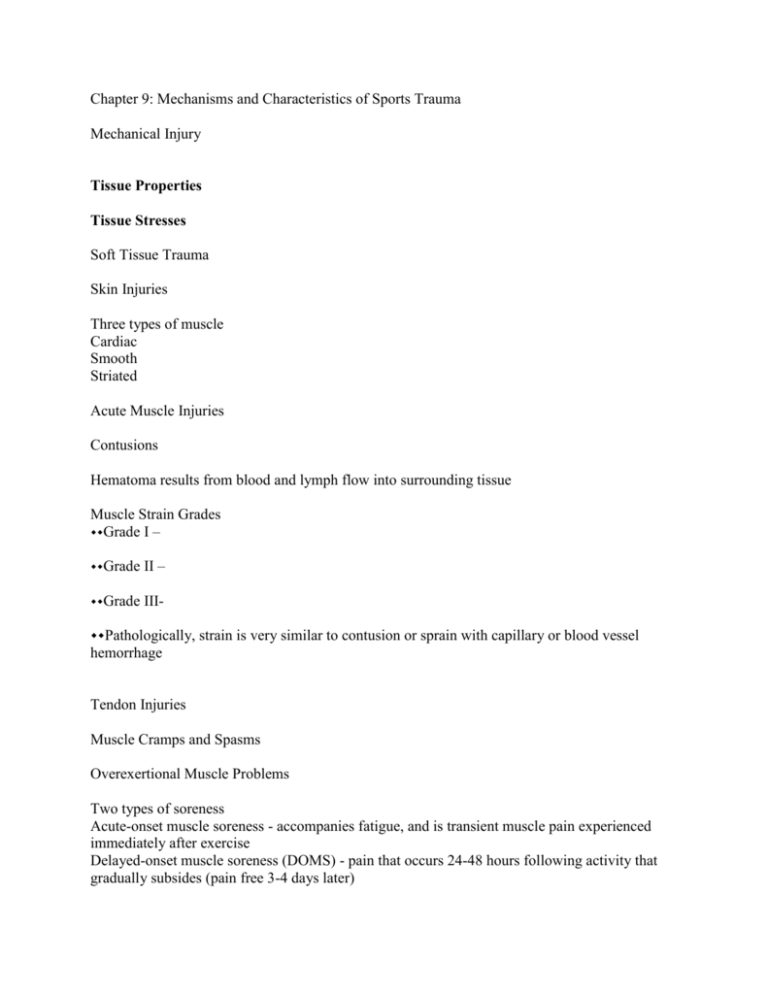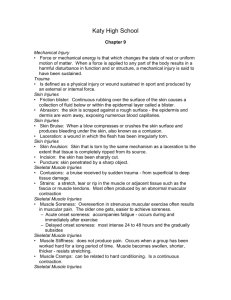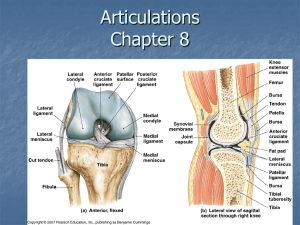Chapter 9: Mechanisms and Characteristics of Sports Trauma
advertisement

Chapter 9: Mechanisms and Characteristics of Sports Trauma Mechanical Injury Tissue Properties Tissue Stresses Soft Tissue Trauma Skin Injuries Three types of muscle Cardiac Smooth Striated Acute Muscle Injuries Contusions Hematoma results from blood and lymph flow into surrounding tissue Muscle Strain Grades Grade I – Grade II – Grade III- Pathologically, strain is very similar to contusion or sprain with capillary or blood vessel hemorrhage Tendon Injuries Muscle Cramps and Spasms Overexertional Muscle Problems Two types of soreness Acute-onset muscle soreness - accompanies fatigue, and is transient muscle pain experienced immediately after exercise Delayed-onset muscle soreness (DOMS) - pain that occurs 24-48 hours following activity that gradually subsides (pain free 3-4 days later) Muscle Stiffness Muscle Cramps Muscle Guarding Myofascial Trigger Points Chronic Musculoskeletal Injuries Myositis/fascitis Calcium at the heel Atrophy and Contracture Generally the result of a muscle injury which impacts the joint, resulting in accumulation of scar tissue Synovial Joints Joint Capsule Bones are held together by a fibrous cuff Consists of bundles of collagen and function to maintain relative joint position Extremely strong and can withstand cross sectional forces Will be slack or taut depending on joint movement Ligaments Synovial Membrane Articular Cartilage Provides firm flexible support - semifirm connective tissue with primarily ground substance No direct blood or nerve supply Fibrocartilage: makes up vertebral disks, symphysis pubis and menisci Nerve Supply Capsule, ligaments, outer aspects of synovial membrane and fat pads are well supplied Inner structures (synovial membrane, cartilage and articular cartilage) also supplied Myelinated mechanoreceptors provide joint position sense in fibrous capsule Non-myelinated fibers supply blood vessels and pain receptors Types of Synovial Joints 6 types ball and socket – hinge pivot ellipsoidal saddle gliding Functional Synovial Joints Synovial Joint Stabilization Articular Capsule and Ligaments Synovial Joint Trauma Synovial Joint Injury Classifications Graded based on the severity of injury Grade I - some pain, minimal loss of function, no abnormal motion, and mild point tenderness Grade II - pain, moderate loss of function, swelling, and instability Grade III - extremely painful, inevitable loss of function, severe instability and swelling, and may also represent subluxation Can result in joint effusion and swelling, local temperature increase, pain and point tenderness, ecchymosis (change in skin color) and possibly an avulsion fracture Most vulnerable joints include ankles, knees, and shoulders Sometimes difficult to distinguish between sprain and tendon strain Repeated joint twisting could result in arthritis or chronic inflammation Acute Synovitis Subluxations, Dislocations and Diastasis High level of incidence in fingers and shoulder Subluxations are partial dislocations causing incomplete separation of two bones Luxation presents with total disunion of bone apposition between articular surfaces Diastisis is the disjointing of 2 parallel bones or rupture of a solid joint (symphysis pubis) Ankle Edema Chronic Joint Injuries Osteochondrosis Bursitis Bone Functions Body support Organ protection Movement (through joints and levers) Calcium storage Formation of blood cells (hematopoiesis) Types of Bone Classified according to shape Flat bones - skull, ribs, scapulae Irregular bones - vertebrae and skull Short bones- wrist and ankle Long bones - humerus, ulna, tibia, radius, fibula, femur bones most commonly injured Bone Trauma Classifications Periostitis Acute bone fractures Type of fractures include, depressed, greenstick, impacted, longitudinal, oblique, serrated, spiral, transverse, comminuted, blowout, and avulsion Stress fractures- no specific cause but with a number of possible causes Overload due to muscle contraction, altered stress distribution due to muscle fatigue, changes in surface, rhythmic repetitive stress vibrations Major signs and symptoms include focal tenderness and pain, (early stages) pain with activity, (later stages) pain becomes constant and more intense, particularly at night, positive percussion tap test Common sites involve tibia, fibula, metatarsal shaft, calcaneus, femur, pars interarticularis, ribs, and humerus Management varies More easily managed and healed if on compression side of bone vs. tension (may result in complete fx) Running Fracture Nerve Trauma Nerve Injuries Two main causes of injury - compression and tension May be acute or chronic Body Mechanics Microtrauma and Overuse Syndrome Injuries as a result of abnormal and repetitive stress and microtraumas fall into a class with certain identifiable syndromes Frequently result in limitation or curtailment of sports involvement Often seen in running, jumping, and throwing activities Some of these injuries while small can be debilitating Repetitive overuse and stress injuries include Achilles tendinitis, shin splints, stress fx, Osgood-Schlaters disease, runners and jumpers knee, patellar chondromalacia and apophyseal avulsion Postural Deviations Often an underlying cause of injury May cause unilateral muscle use as well as bony and soft tissue asymmetries Results in poor pathomechanics Imbalance is manifested by postural deviations as body tries to regain balance relative to CoG Injury generally becomes chronic and participation must stop Athletic trainer should attempt to correct postural conditions Postural conditions can make athletes exceedingly more prone to injury








